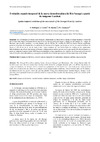Identificador persistente para citar o vincular este elemento:
https://accedacris.ulpgc.es/jspui/handle/10553/106704
| Título: | Evolución espacio temporal de la nueva desembocadura del Río Senegal a partir de imágenes Landsat | Otros títulos: | Spatio-temporal evolution of the new mouth of the Senegal River by Landsat | Autores/as: | Rodríguez, Silvia Alonso Bilbao, Ignacio Sanchez, MJ Casamayor Font, Mariona |
Clasificación UNESCO: | 251090-1 Geología marina. Dinámica sedimentaria 250616 Teledetección (Geología) |
Palabras clave: | Langue de Barbarie Coastal erosion Sediment transport Satellite image Digitization |
Fecha de publicación: | 2015 | Editor/a: | Sociedad Geológica de España | Publicación seriada: | Geotemas (Madrid) | Conferencia: | VIII Jornadas de Geomorfología Litoral | Resumen: | El río Senegal es frontera entre Senegal y Mauritania. La fuerte deriva litoral, el oleaje incidente y la acción
del río han dado lugar a la formación de una de las flechas de arena más largas y dinámicas del mundo: La Langue de
Barbarie, que discurre paralela a la costa durante más de 40 km. En octubre de 2003 las fuertes lluvias registradas
pusieron en peligro de inundación a la población del interior de la laguna, por lo que se realizó un canal en la barra de
arena a 7 km al sur de la isla de Saint Louis. Como resultado de este hecho hubo un cambio en las condiciones
hidrodinámicas que afectó gravemente al balance sedimentario a ambos sectores en los que quedó dividida la barrera. A
partir de imágenes Landsat desde 2003 hasta la actualidad se han cuantificado los cambios en el área más próxima a la
zona de la nueva desembocadura, y se propone un modelo de evolución que explica el funcionamiento de la misma. The Senegal River flows making border between Senegal and Mauritania. The strong littoral drift, the incident waves and the river action have resulted in the formation of highly dynamic spit over 40 km long known as Langue de Barbarie. In October 2003 a channel was performed on the barrier to 7 km south of the island of Saint Louis. As a result of this fact there was a change in the hydrodynamic conditions, which seriously affect to the balance of sediment in the two sectors where the spit was divided. Using data obtained from Landsat images, changes in the area have been quantified and an evolution model is proposed that explains the functioning of the new mouth of the Senegal River. |
URI: | https://accedacris.ulpgc.es/handle/10553/106704 | ISSN: | 1576-5172 | Fuente: | Geotemas ( Madrid ) [ISSN 1576-5172], v. 15, p. 133-136 | URL: | http://dialnet.unirioja.es/servlet/articulo?codigo=7845918 |
| Colección: | Artículos |
Visitas
92
actualizado el 06-abr-2024
Descargas
41
actualizado el 06-abr-2024
Google ScholarTM
Verifica
Comparte
Exporta metadatos
Los elementos en ULPGC accedaCRIS están protegidos por derechos de autor con todos los derechos reservados, a menos que se indique lo contrario.
